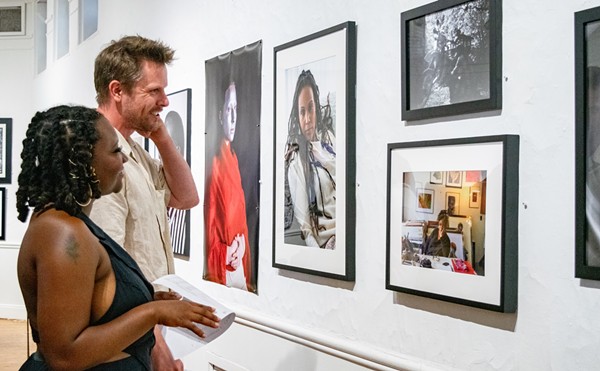In Chicago a few years ago, I worked at an art gallery that had an exhibition of street art. One of the featured works was Detroit's own Slim's Bike, a pimped-out bike built up from recycled junk, plastered with photos of kinky ladies, and once ridden around the Cass Corridor by James "Slim" Thompson. The bike had been salvaged by artist Chris Turner and filmmaker Ben Hernandez, and I was excited to see it celebrated in Chicago. I ended up staying at home and mending a broken bone the night of the opening, but did I hear about it when I returned to work the following week.
"What is up with Detroiters?" my boss asked incredulously Monday morning, pouncing on me as I walked through the front door. He went on for about 20 minutes, giving me his impression of Detroit's enthusiastic creative community. He tends to exaggerate, but according to him, many who had caravanned from here showed up wearing "Detroit" on T-shirts and baseball caps; some had branded their bodies with Motor City tattoos. I didn't know how to explain it without traveling decades back in time, so I just told him Detroiters like to show deep love for their big mama.
New York-based art dealer and educator Klaus Kertess is currently experiencing a similar phenomenon. As guest curator for the inaugural exhibition at the Museum of Contemporary Art Detroit (MoCAD), set to open in October, Kertess, who's curated the Whitney Biennial and launched the careers of such heavy hitters as Chuck Close and Brice Marden, is awed by Detroit cheerleaders, both here and around the country.
"What's really struck me, more than anything, is that in New York, people are stopping me on the street to tell me how excited they are," Kertess says about the project. "I recently went to Chelsea, and three different people rushed up to me, saying, 'I'm from Detroit, and I'm so happy this is happening.' One artist, who used to be Julian Schnabel's studio assistant, called me out of the blue and said, 'You never knew I lived in Detroit, but all my work from the last three years is about Detroit.'"
I think sometimes we get a bit insecure that our civic pride is quaint regionalism. It's a point that hits home when Kertess talks about what it was like bringing in artists in preparation for this first show. Several of them who were visiting the city for the first time fell for her just as hard.
MoCAD has been a long time coming, but finally, after years of pushing and pulling, it seems it's finally imminent. The institution has found its home in a 21,000-square-foot building on the corner of Woodward Avenue and Garfield, across the way from the Whitney restaurant. The utterly ordinary-looking building was purchased a while back by the Manoogian Foundation, originally with the intention to turn it over to the Detroit Institute of Arts for a contemporary art space. After that fell through, MoCAD decided to rent it. Architect Andrew Zago is currently giving the interior a moderate makeover, and has plans for a more straightforward renovation soon.
Currently, MoCAD is run by a volunteer committee, including longtime Detroit art critic Marsha Miro, who's acting as director until a permanent director is hired. Artist Mitch Cope is curator, and other members include long time art advocates Burt Aaron, Lynn Crawford and Julie Taubman. A board of trustees, some of whom are also on the steering committee, funds the nonprofit organization. They plan to feature a series of revolving exhibitions led by nonresident curators, showing off what's new in the contemporary art world. So far, they only have two shows planned and Kertess is guest curator for the inaugural exhibition.
Kertess has selected nine artists from both coasts for Meditations in an Emergency, an exhibit of mostly installation work by such international names as Barry McGee, Mark Bradford, Paul Pfeiffer, Nari Ward, Roxy Paine and Kara Walker. Half of them are making new work, specifically for this show. That doesn't happen regularly, and certainly not for a museum without a reputation. What's more, a few of the artists who'd never been to Detroit before were so struck by the environment that they'll be incorporating it into their work. Sound familiar? That ain't just a local game.
New York-based sculptor Nari Ward's work is serendipitously site-specific. Known for creating exquisitely somber installations, such as one in which he filled an abandoned firehouse with hundreds of busted-up baby carriages, Ward was so taken with a particular pool of detritus in the MoCAD building that's he's using old tiles and sludge from ceiling leakage to create chairs and sand for a scene Kertess calls "an alien beach."
Nomadic graffiti artist Barry McGee — street name "Twist" — plans to spray-paint what will probably be a figurative explosion on the facade of the building. He may in fact steal the show with a performance, since he'll be out there painting the large-scale mural before Meditations in an Emergency even opens. (Incidentally, McGee is a bicoastal cult figure known to mark his territory when he comes to town.)
When considering which artists to invite, Kertess wanted to put up a painting show, but the walls are too inhospitable for paintings. And when local artist Scott Hocking took him on a tour of the city, that's when Ketress realized, "The city is overwhelmed by devastation, and yet there's an amazing spirit." But he wasn't looking to romanticize the blight in the show.
Matter of fact, he wasn't looking to represent one style at all. "The whole art world is so pluralistic, not one style or constellation of styles persists," he says. Instead, the installations and video art featured in Meditations in an Emergency would work just as easily if you shipped it to Chicago or Los Angeles. But Kertess and his group of iconoclasts couldn't ignore the immediate and intimate sense of place you feel just being here, and it seems they're carving art in that spirit. It's a good sign.
In conjunction with the exhibit, MoCAD is producing a full-color hardcover photo book on Detroit.
Cope, who's art director for the publication, says he wants to show "the good, the bad and the ugly in this city," while trying to steer clear of clichéd imagery, which he admits can be tricky.
In an effort to turn the process into a learning experience, Cope has spent several weeks adventuring around town to sites unseen with several photographers. Imagery to be featured includes Mark Powell's intimate portraits of people, Antonio Gomez's sweet and sensitive portraits of families in southwest Detroit, Scott Hocking's unusual landscape photos, Ingo Vetter's portraits of local students and activists (including urban agriculturalists and political figures), Michelle Andonian's photos of the Rouge plant and Greg Holm's field photography.
Detroit's landscape can be mesmerizing. If you stand still long enough, the city will completely alter itself, sometimes even right in front of you in a matter of seconds. Being patient and waiting for that moment is what Holm excels at with his five-minute exposures, what Cope calls "the anti-drive-by." I realize just how much effort it takes when I go out on a Sunday night shoot with Cope and Holm to an abandoned house on the corner of Mack Avenue and St. Aubin.
The setup was an arduous two-day process. Holm, Cope and architect Gina Reichert had already scouted out the empty building a couple of nights earlier. While testing out the lighting and angles, the crew was confronted by a neighbor who was angry about the huge, glaring spotlight used to paint light back and forth across the house for the photo. After several attempts at conversation, they finally got the name of the landlord, who sent out his maintenance man Yohane Terry to join us that evening.
On an empty street, uncluttered by parked cars, Dumpsters or scattered trash, the subject is a ramshackle, white, turn-of-the-century duplex with green trim. As we stand around waiting for Holm to get his shot going (one photo can take about a half an hour), architect Brian Hurtienne, who is along out of curiosity, points out the bay window and full Victorian details in wood, the working-class replication of masonry.
Hurtienne's also on hand to shout out to Holm, who's up on a ladder and hidden behind a black cloth, and let him know when the traffic light changes green. That's when Holm turns the camera on. For about 23 seconds, the entire block glows foggy green, covering the house like a filter the color of chlorophyll in a leaf held up to the sun. In the meantime, Cope chats with Terry. They're discussing the possibility of getting Terry a construction gig at a place Cope knows.
"Every time I think I have a sense for what this city is, I am always thrown off by something even more amazing, intense and indescribable," Cope says. This book project has led him all over the city, but he remembers one spot, around Van Dyke and St. Cyril, where about 10 blocks of buildings have been demolished.
"We saw these workers ripping up trees by the roots, shaking them and tossing them on the ground. It was a perfect spot. We had to set up quickly before the sun fell in order to focus, and then had to wait, standing on this mound of stacked trees, for night. Packs of dogs came around, and when it was really quiet, you could hear the call to prayer in Hamtramck from a distance."
In between such peaceful moments of beauty and sadness, Cope has struggled to explain the project to local folks, some of whom haven't been so friendly and could care less about some fancy new museum. He says it was really tough, for instance, to gauge whether a big guy in a boatyard with a mean-looking dog is going to want to pose for a picture or chase you off.
Being in that boatyard, not knowing what kind of resistance you're going to encounter, is kind of similar to what it's been like trying to get this museum going, with supporters falling in and out and the media criticizing while pushing the group to act.
My take is this: MoCAD reps say they want to be one of the leaders in the arts community. People can conjecture about how this will play out, but for now, the gossip is pretty pointless. The proof will be in plain sight soon enough. The doors will swing wide open, and we'll walk in.
Meditations on an Emergency opens Oct. 27 at Museum of Contemporary Art Detroit, 4464 Woodward Ave. The show is followed by Shrinking Cities, parts one and two, a collaboration with Cranbrook Art Museum, opening in February.
Rebecca Mazzei is Metro Times arts editor. Send comments to [email protected]




